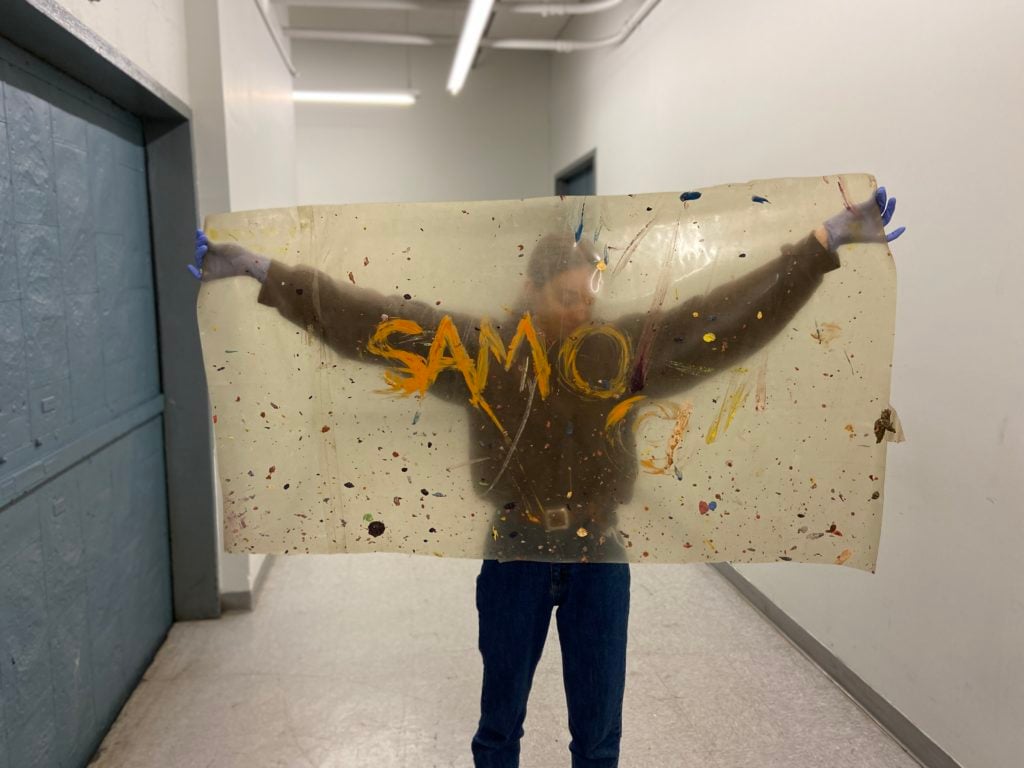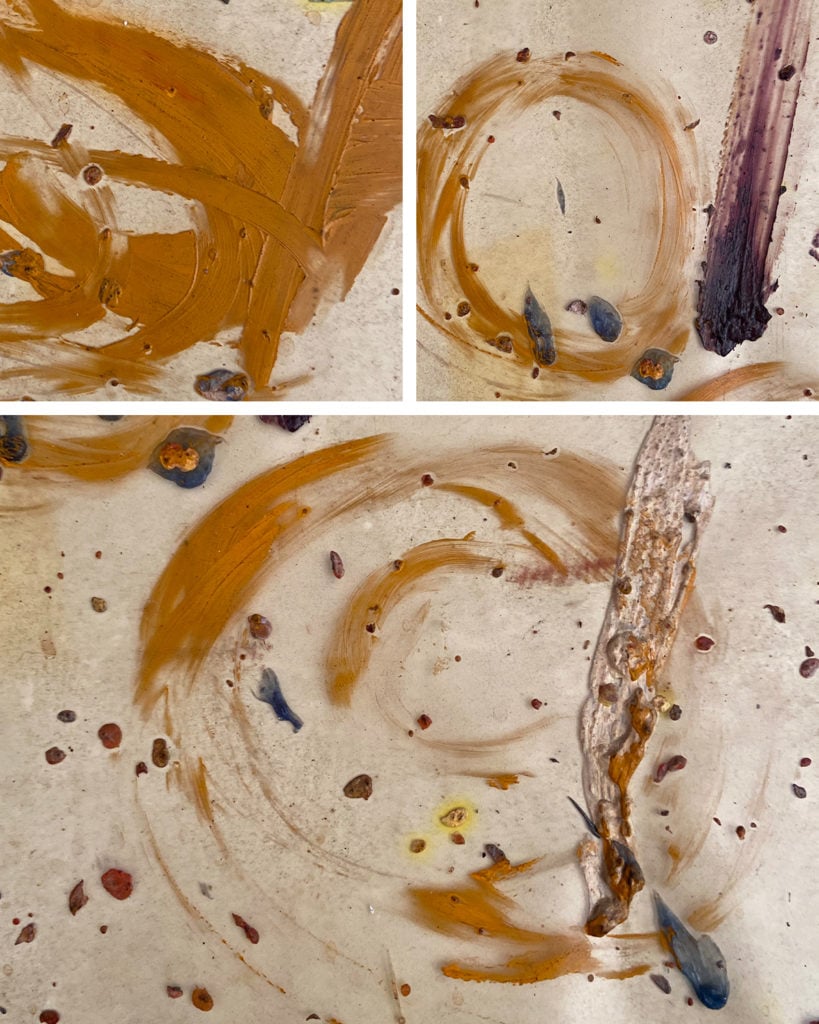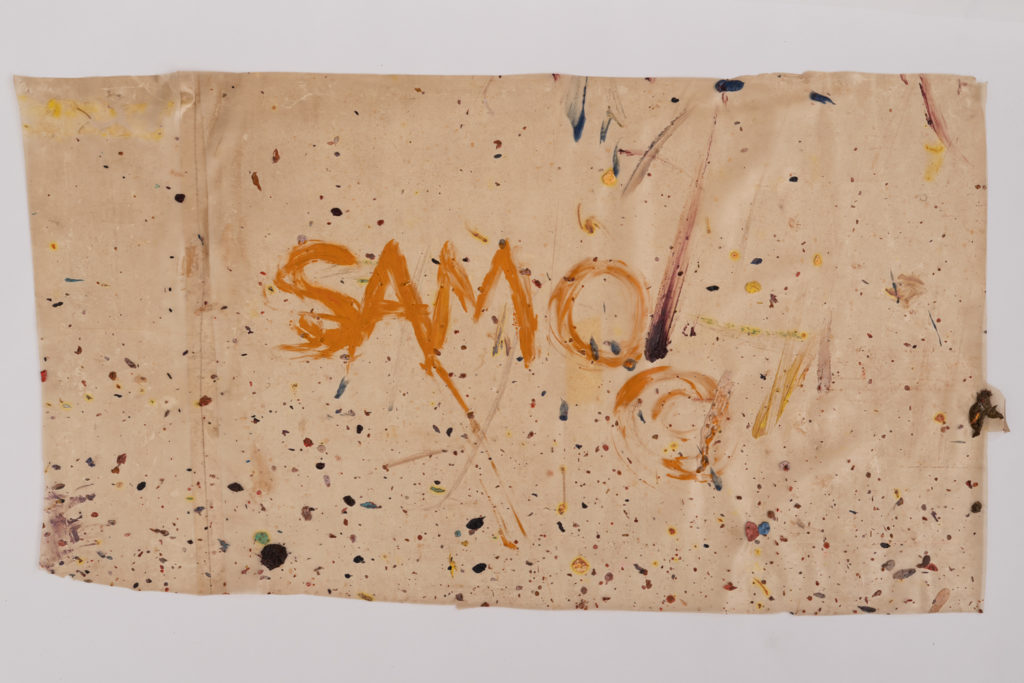Auctions
An Upstart Auction House Just Sold One of Jean-Michel Basquiat’s SAMO Graffiti Tags—the Only Example Ever to Come to Market
The work sold for more than $70,000. But where did it come from?

The work sold for more than $70,000. But where did it come from?

Nate Freeman

In late May, Capsule Auctions, a small house established three years ago out of a storefront in New York’s Alphabet City, announced that it would be auctioning off an oil-on-tarp work by Jean-Michel Basquiat that had never been sold by its original owner. When bidding on the work, which depicts Basquiat’s SAMO tag, opened on May 28, several collectors pushed the price well past the high estimate of $25,000, and it finally hammered, with fees, for $71,875.
“It’s exactly what we want to be selling,” said Simon Baranoff, the cofounder of Capsule. “It’s the kind of unique New York work that we want to bring to market. We’ve sold things for more, but it’s really the direction that we’re excited about—to bring a fresh discovery to market.”

A detail of the lot. Photo courtesy Capsule Auctions.
Just under $72,000 for a modestly sized work by Basquiat is a once-in-a-lifetime steal. Drawings at its scale (it’s five feet by two-and-a-half feet) often sell into the millions, and in 2017, the Japanese billionaire Yusaku Maezawa bought a gigantic Basquiat skull painting for $110.5 million.
What’s more, the Capsule lot is a special rarity in the artist’s oeuvre: a work with his SAMO tag had never before gone to auction, according to the Artnet Price Database. It stands for “same old shit,” but that shrugged-off energy was typical Basquiat-ish misdirection. Basquiat cared deeply about the tag, which he used to plant around Manhattan with artist Al Diaz. Before Basquiat took it over on his own (and killed it off with great fanfare at the end of 1979, writing SAMO IS DEAD all over the city), the tag appeared throughout the East Village, Lower East Side, SoHo, and very prominently around the urban campus of the School of the Visual Arts.
But besides the tag, there’s no other indication that the Capsule work is a Basquiat. It’s not in any catalogue. Nor was it authenticated by the artist’s estate, which disbanded its authentication committee in 2012, after reviewing 2,000 works and deciding it had “fulfilled its goal.” The buyer checked with Diaz prior to making the purchase, and the former half of SAMO said it was made by the hand of the artist.
But its official status is still up in the air. Unlike the world-creating landscapes and gigantic canvas-eating skulls Basquiat would make later in his career, the work is something of an intriguing curio, a Basquiat-related object.

A SAMO tag declaring, somewhat antithetically, that SAMO is dead. Photo courtesy YouTube.
“We priced it as a unique ephemeral work, and then let the market decide where it should be,” Baranoff said.
It clearly had an allure for a Basquiat completist, or even an ardent fan. It’s an artifact from his graffiti days, and such artifacts are rare. “It is a unique situation, an early tag not from a spray can, but from a brush,” Baranoff said. “We hadn’t seen a truly comparable work offered at auction before.”
Though such works are often separated from the paintings and drawings Basquiat made under his own name, his early followers treated them as part of his practice. “Back in the late seventies, you couldn’t go anywhere interesting in Lower Manhattan without noticing that someone named SAMO had been there first,” Jeffrey Deitch wrote in the first-ever published review of Basquiat’s work in Flash Art. “His disjointed street poetry marked a trail for devotees of below-ground art/rock culture.”
But no SAMO works were in the show at Annina Nosei that Deitch reviewed, and not just because Basquiat had moved on. The tags were ephemeral by nature, meant to be impermanent, washable, there and then not.

Film still from Downtown 81, copyright NY Beat Films LLC.
Where did such a strange Basquiat object/artifact/tag came from?
It came to Capsule as part of the estate of a man named Vincent Strautmanis, who died in 2018. The trove, consigned by his widow, Maryellen Strautmanis, mostly consisted of canvases by Strautmanis’s father, a first-wave SoHo artist named Edvins.
Growing up in his father’s Greene Street loft in the 1970s, Vincent spent time with neighborhood kids, including 19-year-old Brooklyn exile Basquiat, who was at the time tagging his nom de graffiti around the gallery-stuffed district and sleeping in Tompkins Square Park and at pads of girlfriends, all the while hustling and self-promoting on the verge of fame.
“My husband was friends with Jean-Michel, he would come over and crash, as everyone knew that Vincent’s father was an artist, and they would hang out and talk art and smoke pot,” Maryellen Strautmanis told me on the phone this week. “Jean-Michel had kind of a crush on my husband’s sister, so he spent a considerable amount of time hanging out on the sofa crashing.”
One day while at the Greene Street loft, in what the family says was 1979, Basquiat approached the tarped-off corner of the apartment where the elder Strautmanis had his studio. Trying to get his attention, the young Jean-Michel found a paintbrush and promptly defiled the makeshift studio’s tarp wall with his notorious tag.
“My father-in-law…—the artist was very upset,” Maryellen Strautmanis said, laughing. “Jean-Michel wasn’t really a fun guy to hang with, he was kind of a pompous jerk, I don’t know why my husband was such good friends with him.”

Jean-Michel Basquiat,Untitled (SAMO© Tarp) 1979. Photo courtesy Capsule Auctions.
Still, Maryellen Strautmanis couldn’t deny the power of having a large Basquiat tag installed in the apartment, both for its historic resonance and aesthetic urgency.
“It’s big, it’s beautiful, and you can totally see the brushstrokes—he dipped it in the paint and slopped this thing on the tarp,” she said. “It was distinctly him.”
Strautmanis doesn’t regret parting ways with it—it had been in the loft for years, and her six children grew up their dad’s stories about how his long-gone famous pal once made a custom work in the same place they grew up. (There’s still a SAMO-tagged haiku that Basquiat left in one of the bedrooms, and Strautmanis says she will sell that one day as well.)
She added that, yes, the tag is more of a piece of Basquiat ephemera than one of his full-fledged artworks. But authenticated or not, it’s imbued with the old magic of the art scene that once flourished around her apartment.
“It was really a piece of SoHo, and a piece of history,” she said. “There’s some great value to have it out there in the world.”